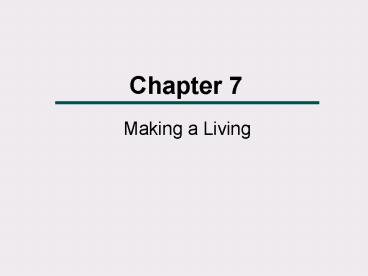Making a Living - PowerPoint PPT Presentation
1 / 28
Title:
Making a Living
Description:
... b Horticulture is a basic form of plant cultivation ... industrial revolution the French revolution the neolithic revolution the aquaculture revolution ... – PowerPoint PPT presentation
Number of Views:91
Avg rating:3.0/5.0
Title: Making a Living
1
Chapter 7
- Making a Living
2
What We Will Learn
- What are the different ways by which societies
get their food? - How do technology and environment influence food
getting strategies? - How have humans adapted to their environments
over the ages?
3
Five Major Food Gathering Strategies
- Food collection collecting vegetation, hunting
animals, and fishing. - Horticulture plant cultivation with simple tools
and small plots of land, relying solely on human
power. - Pastoralism keeping domesticated animals and
using their products as a major food source.
4
Five Major Food Gathering Strategies
- Agriculture horticulture using animal or
mechanical power and some form of irrigation. - Industrialization production of food through
complex machinery.
5
Human Adaptation
- Humans adapt to climates in two ways
- Culturally - dietary patterns, levels of
activities - Biologically - changes in the body
6
Characteristics of Food Collecting Societies
- Low population densities.
- Usually nomadic or semi nomadic rather than
sedentary. - Basic social unit is the family or band.
- Contemporary food-collecting peoples occupy the
remote and marginally useful areas of the earth.
7
Neolithic RevolutionFood Producing Societies
- Transition from food collection to food
production began 10,000 years ago - Humans began to cultivate crops and keep herds of
animals. - Humans were able to produce food rather than rely
only on what nature produced.
8
Changes Resulting From Food Production
- Increased population.
- Populations became more sedentary.
- Stimulated a greater division of labor.
- Decline in overall health reduced the life
expectancy from 26 to 19 years.
9
Why Food Production Led to Declining Health
- Foragers had a more balanced diet (plants and
animal proteins). - Farmers ran the risk of malnutrition or
starvation if the crops failed. - Increased population brought people into greater
contact and made everyone more susceptible to
parasitic and infectious diseases.
10
Horticulture
- The simplest type of farming, which involves the
use of basic hand tools rather than plows or
machinery driven by animals or engines. - Horticulturalists produce low yields and
generally do not have sufficient surpluses to
develop extensive market systems. - The land is neither irrigated nor enriched by the
use of fertilizers.
11
Pastoralism
- Involves keeping domesticated herd animals and is
found in areas of the world that cannot support
agriculture because of inadequate terrain, soils,
or rainfall. - Associated with geographic mobility, because
herds must be moved periodically to exploit
seasonal pastures.
12
Pastoralism
- Two types of movement patterns
- Transhumance - some of the men in a pastoral
society move their livestock seasonally to
different pastures while the women, children, and
other men remain in permanent settlements. - Nomadism - there are no permanent villages, and
the whole social unit of men, women, and children
moves the livestock to new pastures.
13
Agriculture
- Uses technology such as irrigation, fertilizers,
and mechanized equipment. - Produces high yields and supports large
populations. - Associated with permanent settlements, cities,
and high levels of labor specialization.
14
Agriculture Costs of Greater Productivity
- Can support many times more people per unit of
land than the horticulturalist. - Agriculturalists must devote vast numbers of
hours of hard work prepare the land. - Intensive agriculture requires a much higher
investment of capital.
15
Industrialized Food Production
- Uses more powerful sources of energy.
- Requires
- High levels of technology (such as tractors and
combines) - Mobile labor force
- Complex system of markets
16
Features of Four Major Food Procurement Categories
Foragers Horticulturalist
Population Size Small Small/mod.
Permanency of settlement Nomadic (or semi) Generally sedentary
Surpluses Minimal Minimal
Trade Minimal Minimal
Labor specialization None Minimal
Class differences None Minimal
17
Features of Four Major Food Procurement Categories
Pastoralist Intensive agriculture
Population Size Small Large
Permanency of settlement Nomadic (or semi) Permanent
Surpluses Moderate Usual
Trade Moderate Very important
Labor specialization Minimal Highest degree
Class differences Moderate Highest degree
18
Quick Quiz
19
- 1. _______ is a basic form of plant cultivation
using simple tools, small plots of land, and
relies on human power. - Pastoralism
- Horticulture
- Food collection
- Agriculture
20
Answer b
- Horticulture is a basic form of plant cultivation
using simple tools, small plots of land, and
relies on human power.
21
- 2. The gathering of wild vegetation and the
hunting of small game is the strategy of - horticulture.
- pastoralism.
- agriculture.
- food collection.
22
Answer d
- The gathering of wild vegetation and the hunting
of small game is the strategy of food collection.
23
- 3. It is not until ________, some 10, 000 years
ago, that human beings began producing food by
horticulture or animal husbandry. - the industrial revolution
- the French revolution
- the neolithic revolution
- the aquaculture revolution
24
Answer c
- It is not until the neolithic revolution some 10,
000 years ago, that human beings began producing
food by horticulture or animal husbandry.
25
- 4. Traveling with their animals, ________ do not
have permanent settlements, and the whole social
unit moves with their animals. - agriculturalists
- food collectors
- horticulturalists
- nomads
26
Answer d
- Traveling with their animals, nomads do not have
permanent settlements, and the whole social unit
moves with their animals.
27
- 5. Because of its reliance on animal power and
technology, ________ differs from horticulture,
and is a more intensive and efficient system. - horticulture
- nomadism
- agriculture
- pastoralism
28
Answer c
- Because of its reliance on animal power and
technology, agriculture differs from
horticulture, and is a more intensive and
efficient system.































